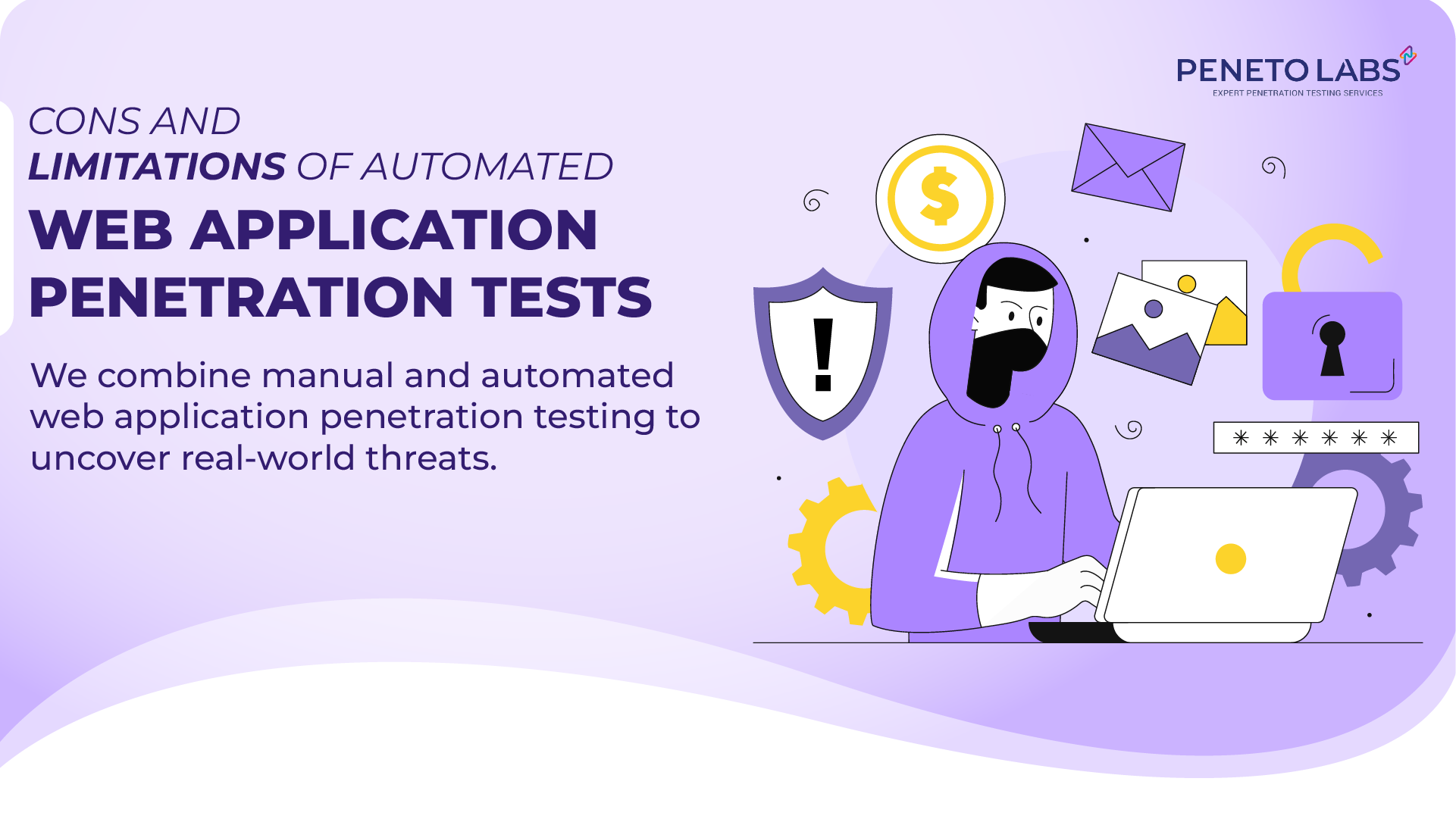Automated tools for web application penetration testing are fast and affordable. They scan applications for common issues and generate instant reports. However, they are not enough when it comes to building a strong security. If you rely only on automated web application penetration tests, you risk missing serious threats that can compromise your business.
Automated Web Application Penetration Tests Alone Is Not Enough
Automated tools run on predefined signatures and scanning patterns. They are effective for addressing basic issues, such as outdated software, missing patches, or weak configuration. Using them alone to protect your web application doesn’t work because attackers today use advanced methods and automated tests often fail to detect complex or chained vulnerabilities.
Cons of Automated Web Application Penetration Testing
Below, we have listed some of the cons of Automated Web Application Penetration Tests.
1. Misses Complex Vulnerabilities
Automated tools often fail to detect logic flaws, chained exploits, or business logic vulnerabilities. These require human understanding and cannot be picked up by scanners.
2. Limited Context Awareness
Automated tools cannot fully understand how a web application works in real-world use. They may overlook vulnerabilities hidden in workflows like multi-step logins or payment gateways.
3. Poor at Testing Custom Applications
Every web application is different. Automated testing struggles with custom-built apps, APIs, or unique integrations, leaving blind spots in coverage.
4. No Guidance on Remediation
Automated reports usually list vulnerabilities without clear, actionable advice. This leaves IT and compliance teams guessing how to fix the issues effectively.
Key Limitations of Automated Web Application Penetration Tests
Below, we have listed some of the cons of Automated Web Application Penetration Tests.
1. Limited Detection of Business Logic Flaws
Automated scanners can’t understand how your application’s logic works. For example, a shopping cart that allows negative pricing is a flaw only a human tester can identify.
2. False Positives and False Negatives
These tools sometimes mark harmless issues as high-risk (false positives) or completely miss real vulnerabilities (false negatives). This wastes time for security teams.
3. Lack of Contextual Understanding
A scanner cannot judge the actual business impact of a vulnerability. For instance, an open directory on a non-critical page may be low risk, while the same issue on an admin panel is critical.
4. Inability to Test Authentication and Sessions Properly
Automated tools struggle with complex authentication flows like multi-factor authentication (MFA), token-based logins, or CAPTCHAs. Hackers exploit weak session management, but scanners may overlook it.
5. No Real Exploit Simulation
Scanners highlight risks but rarely exploit them. Without exploitation, you don’t know the real depth of the issue. A vulnerability might look minor but lead to full data exposure.
6. Struggles With APIs and Modern Frameworks
Most apps today rely on APIs, mobile backends, and cloud-hosted services. Automated tools often miss flaws in these areas because they require custom testing and logic.
7. Limited Support for Complex Environments
If your app runs in hybrid cloud, uses microservices, or integrates with multiple third-party systems, automated testing alone cannot cover the attack surface.
Manual Testing Complements Automation
Manual web application penetration testing conducted by certified experts fills the above-mentioned gaps. Humans can think like attackers, test unusual scenarios, and exploit vulnerabilities the way real hackers would. A combined approach of automation and manual testing ensures complete coverage.
The Risk of Over-Reliance on Automation
Businesses that depend only on automated web application security testing often fall into a false sense of security. They think a clean report means their app is safe. In reality, many high-profile breaches happened because complex vulnerabilities went unnoticed by automated scans.
Comprehensive Manual and Automated Web Application Penetration Testing by Peneto Labs
At Peneto Labs, we deliver more than automated scans. Our CERT-In empanelled experts hold certifications like OSCP, OSCE, GWAPT, and GCIH. We combine manual and automated web application penetration testing to uncover real-world threats. Our detailed, compliance-ready reports highlight risks, their impact, and clear remediation steps.
We also offer free retesting within the audit window to ensure your fixes work. With proven experience across banking, fintech, healthcare, and enterprise apps, we help you stay secure and compliant with confidence.
Conclusion
Automated web application penetration tests are useful, but they are not enough on their own. Scanners can detect common vulnerabilities, yet they often miss deeper issues like business logic flaws, chained exploits, and context-specific risks. Relying only on automation creates a false sense of security that leaves critical gaps open for attackers.
The smarter approach is a balanced one, use automated scans for speed, but back them up with expert-led manual penetration testing. This combination ensures thorough coverage, actionable insights, and compliance with regulatory expectations.
If your goal is to truly protect sensitive data and customer trust , don’t settle for automation alone. Invest in professional web application security testing, such as that offered by Peneto Labs, which combines both automation and human expertise.
